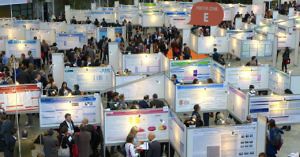ESMO16 Gems from the Poster Halls Part 2
One of our popular series from conferences is Gems from the Poster Halls, where we take a look at some of the studies or research data that caught our attention and explain how they may have future significance. In the past, posters have lead to phase 2 or 3 trial designs and subsequent approval. Others have sadly missed signals in small studies that could have prevented an expensive phase 3 faiure. Hence, it is often important to pay attention to posters.

The ESMO16 Poster Hall Maze
Posters can also give early warning for what’s developing in pipelines. The BTK inhibitor, ibrutinib, was originally codenamed CRA–032765 (at Celera) and later PCI–32765 (at Pharmacyclics), for example, while the PI3K-delta inhibitor, idelalisib started life as CAL–101 (at Calistoga). We previously followed the progress of these compounds while they were in preclinical and phase 1 and documented progress long before they became active drugs in a race to market in CLL.
My favourite codename is always going to be STI–571 (imatinib). We would start planning ASCO and ASH activities every January and September, so companies should be well in hand in their preparations for ASH and SABCS by now. There’s a tremendous amount of work involved behind the scenes in order to have a great event, and I’m not talking about the fripperies like exhibits and light boxes here.
Last year at ECCO, StemCentRx burst on the scene and were subsequently acquired at a significant premium by AbbVie, taking quite a few people by surprise.
So what can we learn about the data from ESMO this year? What new trends are emerging this time around?
Here, we take a fresh look at FOUR interesting new developments from small and large pharma/biotech companies alike in Part 2 of the Gems series. In the first one [Link], we interviewed an expert and discussed their approach to biomarkers in early small studies to help them better design larger follow-on trials more effectively.
To learn more about our insights, Subscribers can log in..
This content is restricted to subscribers

 Spring has arrived in many parts of the world, and with it I am always reminded of William Wordsworth’s classic poem, “I Wandered Lonely as a Cloud:”
Spring has arrived in many parts of the world, and with it I am always reminded of William Wordsworth’s classic poem, “I Wandered Lonely as a Cloud:”